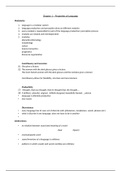Chapter 1 – Properties of Language
Modularity
1. language is a modular system
2. language production and perception draw on different modules
3. every module is responsible for part of the language production/ perception process
4. modules are related and interdependent
5. modules:
phonetics/phonology
morphology
syntax
lexicon/semantics
pragmatics
discourse organization
Constituency and recursion
(1) She gives a lecture.
(2) The woman with the dark glasses gives a lecture.
The short haired woman with the dark glasses and the necklace gives a lecture
Constituency allows for flexibility, structure and recursiveness
Productivity
(7) I thought, that you thought, that he thought that she thought....
(8) A brilliant, colourful, original, skilfully designed, beautifully framed ... picture
• language is infinitely productive
• new words
Discreteness
• every language has its own set of discrete units (phonemes, morphemes, words, phrases etc.)
• what is discrete in one language, does not have to be in another
•
Arbitrariness
• no relation between sound and meaning of a word
chair /tʃeə(r)/
• onomatopoetic word
• sound inventory of a language is arbitrary
• patterns in which sounds and words combine are arbitrary
,Context dependence
(9) bank = the land alongside or sloping down to a river or lake
vs.
bank = organization that provides financial services
vs.
bank = to travel with one side higher than the other
(10) their vs. there vs. they're
(11) right vs. write
Variability
• some universal characteristics
• differences between individual languages
• differences between speakers of the same language
• language use of individual speakers differs depending on situation and people they speak to
• language is used to establish social identity
• standard vs. nonstandard varieties
WEEK 2
Language disciplines – Phonetics
The branch of linguistics that deals with the sounds of speech and their pronunciation, combination,
description and representation by written symbols.
Language disciplines – Phonology
The branch of linguistics that deals with the distribution and patterning of speech sounds in a
language and with the tacit rules that govern pronunciation.
Articulation – how sounds are made
1. Air stream mechanism, usually moving air out of lungs
2. Vocal folds (vibration = voiced sounds; aspiration)
3. Velum (open = nasal sounds, closed = oral sounds)
,4. Which articulator used and how it is used
Type of articulator and location of constriction = place of articulation
Sort of constriction = manner of articulation
How are speech sounds made? Manner of articulation
Manner of articulation = the way in which air stream is released
1. stops (air flow is cut off completely, examples [p], [t], [k])
2. fricatives (air flow is not blocked, but restricted, the air stream
becomes noisy, examples [s], [z], [f], [v])
3. affricates (a stop + fricative in one sound)
4. approximant (restriction of air flow without the friction of fricative)
5. glides -> laterals & rhotics
laterals (air flow over the sides of tongue, l-sounds)
rhotics (r –sounds, a lot of variation across languages)
6. nasals (air flow via the nose, examples [m], [n], [ŋ]
Obstruents
Oral stops, fricatives and affricates
Restriction of air flow results in a hissing sound
Sonorants
Nasal stops, approximants and vowels
Sound are made via the vibration of the vocal folds, they are always voiced
Place of articulation
- Bilabial [p], [b] & [m]
- Labiodental [f], [v]
- Dental [θ] (] (thin) [ð] then
- Alveolar [t], [d], [n] & [l], [s] [z]
- Postalveolar [ʃ], [ʒ] & [ʧ], [ʤ]
, - Palatal [j]
- Velar [k], [g], [ŋ]





